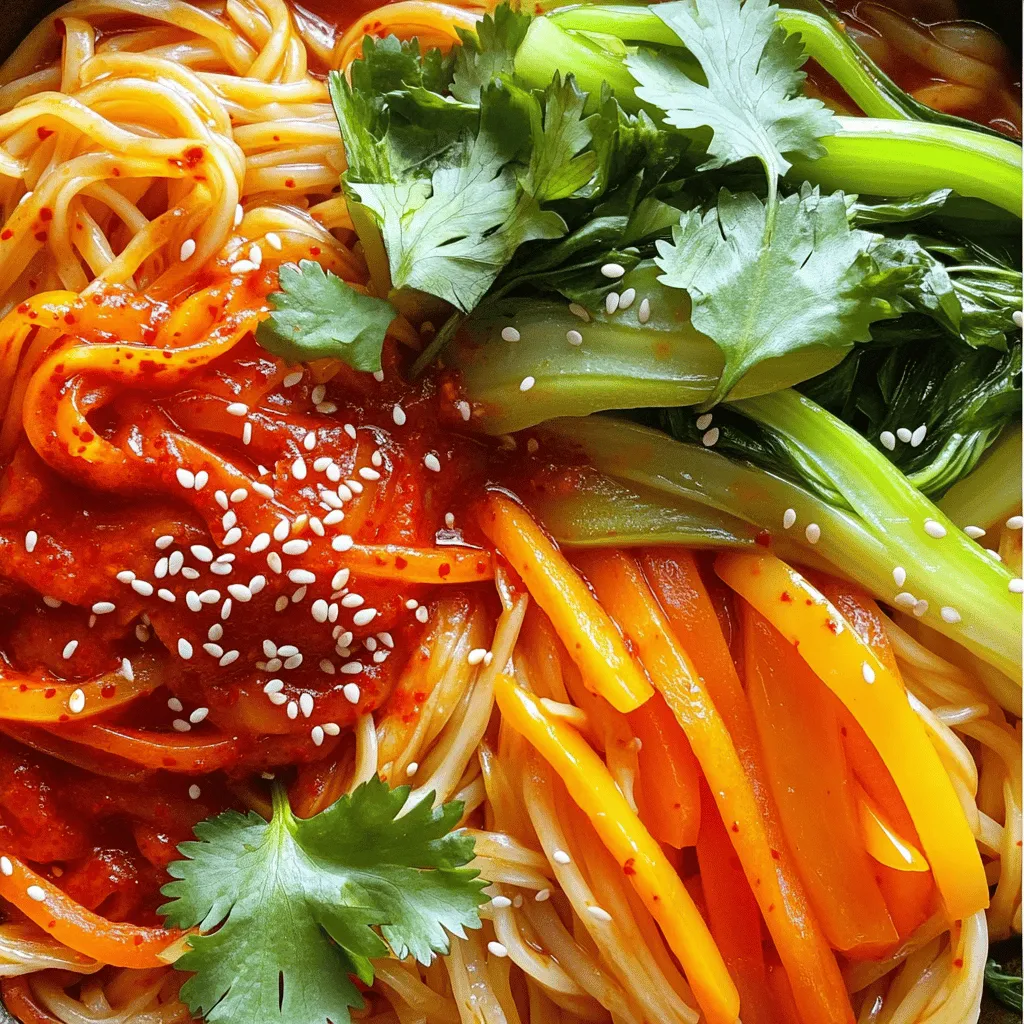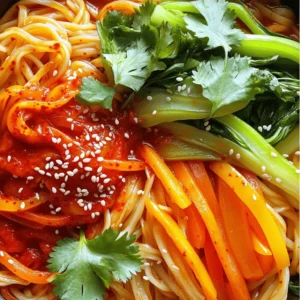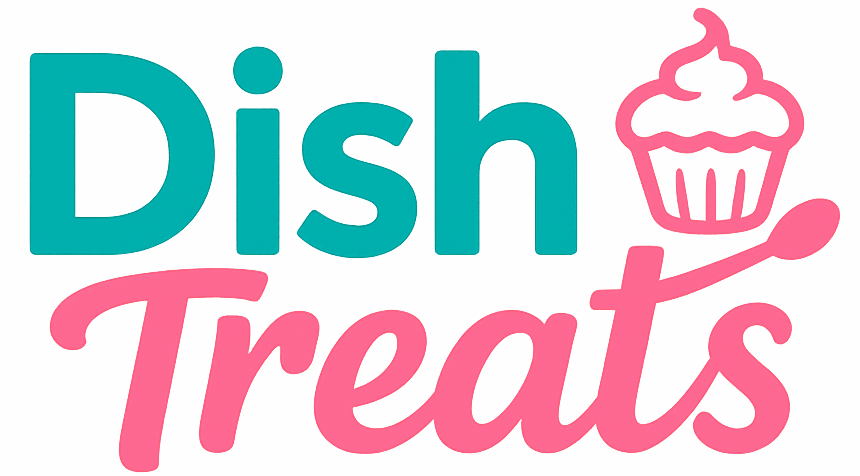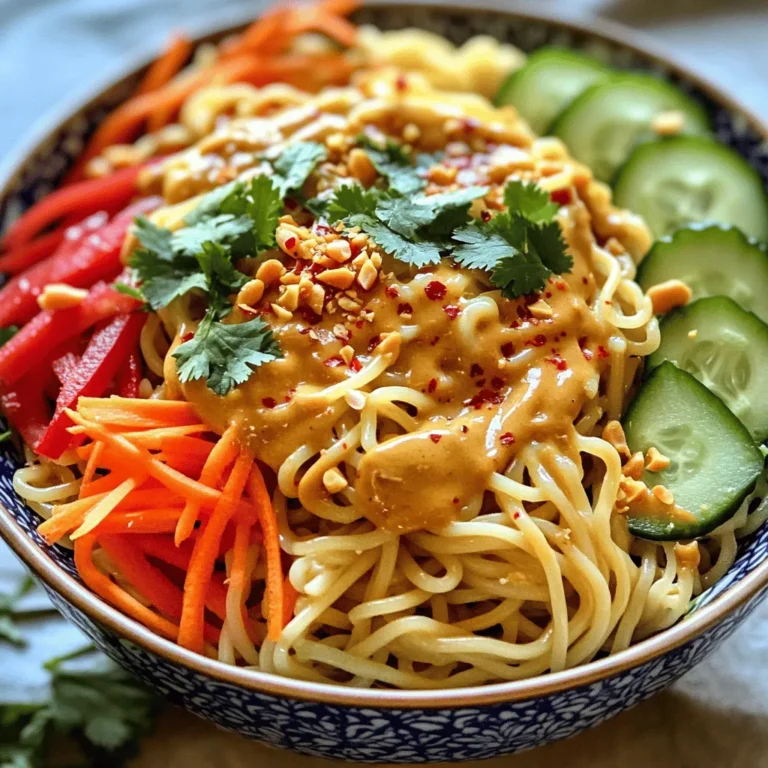Spicy Gochujang Noodles Quick and Flavorful Dish

Are you ready to bring some heat to your dinner table? These Spicy Gochujang Noodles are quick to prepare and bursting with flavor! Using a few simple ingredients, you can create a delicious dish that pleases even the pickiest eaters. Whether you’re a busy parent or a student, this meal fits your schedule. Join me as we dive into this exciting recipe that will spice up your weeknight meals!
Ingredients
Required Ingredients
- 200g thick rice noodles
- 2 tablespoons gochujang (Korean chili paste)
- 1 tablespoon soy sauce
- 1 tablespoon sesame oil
- 1 tablespoon honey (or maple syrup for a vegan option)
- 1 teaspoon grated fresh ginger
- 2 cloves garlic, finely minced
- 1 cup bok choy, roughly chopped
- 1 medium carrot, julienned
- 1 bell pepper (any color), thinly sliced
- 2 green onions, finely chopped
- Sesame seeds, for garnish
- Fresh cilantro leaves, for garnish
Optional Ingredients
- Additional protein options (chicken, tofu, shrimp)
- Other vegetables (mushrooms, zucchini, spinach)
Gathering the right ingredients is the first step to making spicy gochujang noodles. Thick rice noodles are key, giving the dish a chewy texture. Gochujang adds heat and depth. The soy sauce and sesame oil bring umami and richness. Honey or maple syrup balances the spice with a touch of sweetness.
Fresh ginger and garlic provide a fragrant kick. Bok choy, carrots, and bell peppers add color and crunch. Green onions, sesame seeds, and cilantro finish the dish with fresh notes.
If you want to customize your meal, feel free to add proteins like chicken or tofu. You can include more veggies too, like mushrooms or zucchini. Have fun mixing and matching!
Step-by-Step Instructions
Cooking the Noodles
To cook thick rice noodles, start by boiling water in a large pot. Once the water is bubbling, add 200g of thick rice noodles. Cook them for about 8-10 minutes, or until they feel soft. When they are done, drain them well and rinse under cold water. This stops the cooking and keeps them from getting sticky. Set the noodles aside in a colander.
Preparing the Gochujang Sauce
In a small bowl, mix 2 tablespoons of gochujang with 1 tablespoon of soy sauce, 1 tablespoon of sesame oil, and 1 tablespoon of honey. You can use maple syrup if you want it vegan. Next, add 1 teaspoon of grated fresh ginger and 2 cloves of finely minced garlic. Stir well until it’s smooth. If you like it spicier, add another tablespoon of gochujang.
Sautéing the Vegetables
Use a large skillet for this step. Heat a teaspoon of oil over medium heat. Once hot, toss in 1 cup of roughly chopped bok choy, 1 medium julienned carrot, and 1 thinly sliced bell pepper. Sauté these for about 4-5 minutes. Stir them often until they are tender but still crisp.
Tossing Everything Together
Add the cooked noodles to the skillet with the sautéed veggies. Drizzle the gochujang sauce over everything. Use tongs or a spatula to toss them together gently. Make sure the noodles are covered well with the sauce. Cook for another 2-3 minutes to heat everything through.
Final Touches
Once done, take the skillet off the heat and fold in 2 finely chopped green onions. When you serve the noodles, plate them up nicely. Top with a sprinkle of sesame seeds and fresh cilantro leaves for a pop of color and flavor.
Tips & Tricks
Achieving the Perfect Noodle Texture
To cook thick rice noodles, start by boiling water. This is the key to soft noodles. Follow the package instructions for cooking time. Once the noodles are tender, drain them. Rinse them under cold water. This stops cooking and keeps them firm.
Customizing the Flavor
Want more heat? Add an extra tablespoon of gochujang. For sweetness, stir in more honey or maple syrup. You can also mix in other sauces. Try soy sauce or sesame sauce for a twist. This lets you play with flavors.
Preparing Ahead
You can make the sauce ahead of time. Mix gochujang, soy sauce, sesame oil, honey, ginger, and garlic. Store it in the fridge. For veggies, chop them up earlier too. When reheating, add a splash of water. This keeps everything moist and tasty.

Variations
Vegan Alternatives
You can easily make this dish vegan. First, swap honey for maple syrup. Maple syrup adds sweetness and keeps it plant-based. Next, boost the veggies! Try adding mushrooms, zucchini, or spinach. These add flavor and nutrients, making the dish even more colorful.
Gluten-Free Options
If you need gluten-free noodles, look for rice noodles or other gluten-free types. They work well in this recipe. For the sauce, check that your soy sauce is gluten-free. Some brands offer a gluten-free version. This small change ensures everyone can enjoy the meal.
Different Asian Noodle Recipes
Want to mix things up? Use ramen or udon noodles instead. Ramen adds a nice chew, while udon is thicker and heartier. You can also try fusion recipes. Combine gochujang with peanut sauce for a tasty twist. Experimenting with different noodles keeps your meals exciting!
Storage Info
Storing Leftovers
To keep your spicy gochujang noodles fresh, use airtight containers. Glass or plastic containers work well. Make sure the noodles cool down before sealing. Store your leftovers in the fridge for up to three days. Always label the container with the date for easy tracking.
Freezing Tips
You can freeze spicy gochujang noodles for later. First, let the noodles cool fully. Then, place them in freezer-safe bags. Squeeze out as much air as possible. They can last up to three months in the freezer. When you’re ready to eat, thaw them in the fridge overnight. Reheat in a skillet over medium heat with a splash of water for best results.
Shelf Life
Cooked noodles last about three to four days in the fridge. Always check for signs of spoilage. If they smell sour or look slimy, it’s time to toss them. Keeping them stored properly will help you enjoy your delicious meal longer!
FAQs
How spicy are Spicy Gochujang Noodles?
Gochujang has a unique heat. It is spicy but also sweet and deep. The spice level can vary based on brands. If you want more heat, add more gochujang. Taste your sauce before mixing it with the noodles. Adjust to your liking. Balance is key.
Can I use different noodles?
Yes, you can use many types of noodles. Rice noodles are thick and chewy, but other options work too. Try soba, udon, or even spaghetti if you prefer. Each noodle brings its own texture. Just make sure to cook them right.
Where can I buy gochujang?
You can find gochujang in many places. Look in Asian markets or international aisles of grocery stores. Online, sites like Amazon or specialty food shops have it too. Read reviews to find a quality brand.
Is it possible to make this recipe in advance?
Yes, you can prep this dish ahead of time. Cook the noodles and store them separately. Keep the sauce in the fridge. Sauté the veggies right before serving. When ready, just heat everything together. This keeps the noodles and veggies fresh.
What can I serve with Spicy Gochujang Noodles?
These noodles pair well with many sides. Try spring rolls or dumplings for appetizers. A simple cucumber salad adds a nice crunch. You can also serve it with grilled chicken or shrimp for protein. Enjoy mixing flavors!
Spicy Gochujang Noodles are simple to make and packed with flavor. You learned about key ingredients and how to prepare them step by step. Remember, you can customize your dish with different proteins or veggies. Whether you prefer it spicy or sweet, the choice is yours. Lastly, store leftovers properly to enjoy this dish later. Dive into your kitchen and treat yourself to a tasty meal!



![- 8 oz linguine or spaghetti - 1 lb large shrimp, peeled and deveined - 4 cloves garlic, finely minced - 1/4 cup extra-virgin olive oil - 1 teaspoon red pepper flakes - 1/2 cup fresh parsley, finely chopped - 1 lemon, juiced and zested - Salt and freshly ground black pepper to taste - Grated Parmesan cheese (optional) To make Quick Garlic Shrimp Pasta, you need fresh and quality ingredients. The base of this dish is linguine or spaghetti, which holds the sauce nicely. I love using large shrimp because they cook quickly and have a great flavor. Garlic is a must here. It adds a rich, aromatic taste that makes the dish special. Next, the olive oil brings everything together. I always choose extra-virgin for its fresh and fruity flavor. Red pepper flakes add that perfect kick. Adjust the amount to fit your spice level. Fresh parsley brightens the dish, making it look vibrant. The lemon juice and zest add a zesty touch that balances the richness. Don’t forget salt and pepper to enhance all the flavors. If you want to make it extra savory, sprinkle some grated Parmesan cheese on top. These ingredients work together to create a dish that is simple yet full of flavor. For the full recipe, refer to the section above. - Bring a large pot of water to a boil. - Add salt to the water for flavor. - Cook the pasta according to the package instructions. - Reserve about 1 cup of the pasta water before draining. - Heat olive oil in a large skillet over medium heat. - Add minced garlic and red pepper flakes. - Sauté the garlic for about 30 seconds until fragrant. - Introduce the shrimp into the skillet. - Season the shrimp with salt and black pepper. - Cook for about 2-3 minutes until the shrimp turn pink and opaque. - Toss the cooked pasta into the skillet with the shrimp. - Add the reserved pasta water for creaminess. - Pour in lemon juice and zest for brightness. - Fold in the chopped fresh parsley for a fresh taste. - Taste and adjust seasoning if needed. - Plate the pasta into individual bowls. - Garnish with extra parsley and a lemon wedge. - Serve warm and enjoy this dish. For detailed cooking steps, check the Full Recipe. To get the best garlic taste, avoid burning it. When you heat garlic, it should become fragrant but not brown. Burnt garlic can taste bitter and ruin your dish. Start with medium heat and watch it closely. If you like spice, adjust the red pepper flakes. Add more for heat or less for mildness. Taste as you go, and find what suits you best. Cooking pasta to al dente is key. This means the pasta should be firm but not hard. Overcooked pasta can turn mushy and lose its bite. Before draining your pasta, save some pasta water. This starchy water helps the sauce stick and adds flavor. It’s a simple trick that makes a big difference! For side dishes, consider a fresh salad or garlic bread. These pair well with the pasta and add balance to your meal. When it comes to wine, a crisp white wine works best. Look for a Sauvignon Blanc or a Pinot Grigio. These wines enhance the garlic flavors and make the meal feel special. {{image_4}} You can switch up the pasta to fit your needs. Try whole wheat or gluten-free pasta. Both options work well with this dish and add a different taste. Fresh herbs can change the flavor too. Use basil or chives for a fresh twist. They brighten up the shrimp pasta and add a new layer of taste. You can explore other seafood options if you want. Scallops and calamari both taste great in this dish. They offer a nice change from shrimp while keeping the dish light. For a vegetarian version, use mushrooms instead of shrimp. Mushrooms have a meaty texture and soak up flavors well. This swap keeps the dish satisfying without meat. Want a richer sauce? Adding cream can make your dish more decadent. It gives the pasta a smooth texture that many love. You can also add cherry tomatoes for freshness. They pop with flavor and add color to your plate. This small change can elevate your garlic shrimp pasta experience. For a full recipe, check out the details above. To store leftover pasta, place it in an airtight container. Make sure to let it cool first. This helps prevent sogginess. You can keep it in the fridge for up to three days. After that, the shrimp may lose its quality. Always check for any off smells or changes in color before eating. When reheating pasta, use a skillet. This keeps the dish from getting too dry. Add a splash of water or olive oil to help. Heat it on low, stirring gently. Avoid using the microwave if you can. It can make the shrimp rubbery. Always taste a little before serving to ensure it's warm and flavorful. Yes, you can freeze garlic shrimp pasta! First, let the dish cool completely. Then, place it in a freezer-safe container. Leave some space for expansion. You can freeze it for up to two months. To thaw, move it to the fridge overnight. Reheat it on the stove, adding a bit of water or oil to restore moisture. You can make Quick Garlic Shrimp Pasta in about 30 minutes. - Prep time: 10 minutes - Cooking time: 20 minutes Yes, you can use frozen shrimp. Just thaw them first. - To thaw shrimp, place them in cold water for about 15-20 minutes. - Ensure shrimp are peeled and deveined before cooking. You can pair this dish with several sides: - A fresh garden salad - Garlic bread for dipping - Steamed vegetables like broccoli or asparagus To reduce the spice, you can: - Use fewer red pepper flakes or omit them. - Add more olive oil or butter to mellow the heat. I recommend using linguine or spaghetti. - These pasta types hold the sauce well. - You can also try fettuccine for a different texture. For the full recipe, refer to the [Full Recipe]. Quick Garlic Shrimp Pasta is simple and tasty. You learned about key ingredients, cooking steps, and useful tips. I focused on making garlic and shrimp shine while keeping it easy. You can swap out ingredients, store leftovers, and reheat without losing flavor. Try different flavors to make it your own. Follow these steps, and enjoy a delicious meal any day of the week. Cooking should be fun and satisfying, so gather your ingredients and start creating!](https://dishtreats.com/wp-content/uploads/2025/06/6901a993-fcd3-4db1-9297-5790b6f94dfa-768x768.webp)

![- 1 lb (450g) chicken breast, thinly sliced - 1 cup fresh Thai basil leaves, packed - 3 cloves garlic, minced - 2 red Thai chili peppers, thinly sliced (adjust based on your spice preference) For this dish, I prefer chicken breast. It cooks quickly and stays juicy. Fresh Thai basil gives this meal its unique flavor. Garlic adds a nice aroma, and Thai chili peppers bring heat. You can control the spice by adding more or less chili. - 2 tablespoons soy sauce - 1 tablespoon oyster sauce (or substitute with mushroom sauce for vegetarian) - 1 tablespoon fish sauce (or an extra tablespoon of soy sauce for vegetarian) - 1 teaspoon sugar (to balance flavors) - 1 tablespoon vegetable oil (for frying) These sauces are key to great taste. Soy sauce offers saltiness, while oyster and fish sauces add depth. Sugar balances the salty flavors, making everything taste better. - 1 bell pepper, sliced (your choice of color for visual appeal) - 1 small onion, sliced into thin wedges - Optional: other vegetables for added nutrition I like using bell pepper and onion for color and crunch. You can add other veggies like carrots or snap peas. They bring more nutrition and flavor, making the dish more vibrant. For the full recipe, refer to the [Full Recipe]. To start, you need to combine the chicken with the sauces. In a medium bowl, add the sliced chicken breast, soy sauce, oyster sauce, fish sauce, and sugar. Mix these ingredients well so the chicken gets all the flavor. Let it marinate for 15 minutes. This short time helps the chicken absorb the tasty sauces. Next, heat the vegetable oil in a large skillet or wok over medium-high heat. You want the oil to shimmer before adding anything. Then, add the minced garlic and sliced Thai chili peppers. Stir-fry them for about 30 seconds until they smell amazing. Be careful not to burn the garlic. Now, add the marinated chicken to the pan. Spread it out evenly for even cooking. Stir-fry for about 5 to 7 minutes. Cook until the chicken is no longer pink and has a nice brown color. After that, toss in the sliced bell pepper and onion. Stir-fry for another 3 to 4 minutes. This will make the vegetables tender but still crisp. Once the chicken and veggies are done, take the skillet off the heat. Gently fold in the fresh Thai basil leaves. They will wilt quickly from the heat and add a lovely aroma. Serve the dish hot, over a bed of fluffy jasmine rice. This rice complements the stir-fry well. Enjoy your Thai Basil Chicken Stir-Fry! For the full recipe, check out the details above. Using fresh ingredients makes a big difference. Fresh Thai basil gives a sweet and fragrant flavor to the dish. Always choose bright green basil leaves. They should smell strong and sweet. The chicken should be fresh, too. This keeps your stir-fry tasty and safe to eat. For the best flavor, cook on high heat. A hot pan helps to sear the chicken. This adds a nice caramel color and enhances the taste. When you add garlic and chili, cook them quickly. This brings out their strong flavors without burning them. You can change the heat level easily. If you want it milder, remove the seeds from the chili peppers. You can also use fewer peppers or substitute with sweet bell peppers. If you like a kick but want it less spicy, try adding sugar. It balances the heat. You can also use a bit of honey for sweetness without heat. Pair your Thai basil chicken stir-fry with jasmine rice. The rice absorbs the sauce well. You can also add a side of steamed veggies for extra nutrition. For garnishes, consider adding lime wedges or crushed peanuts. They add color and crunch. Fresh cilantro or extra basil leaves also make it pop. Enjoy your meal with these simple touches! For the full recipe, check out the details above. {{image_4}} For a vegetarian or vegan version, you can swap chicken for tofu or tempeh. These options give a nice texture. Use mushroom sauce instead of oyster sauce. It brings depth and umami flavor. For the fish sauce, simply add an extra tablespoon of soy sauce. This keeps the taste bold. To maintain flavor, marinate the tofu or tempeh just like chicken. Allow it to soak up the sauces. When cooking, make sure to press out excess moisture. This helps achieve that nice, crispy texture we all love. If you want to try something new, switch the chicken for shrimp or beef. Shrimp cooks quickly, so cut down the cooking time to about 3-4 minutes. Beef takes longer. Slice it thin and cook it for about 6-8 minutes. Remember, cooking times change based on what protein you use. Always make sure your protein is fully cooked before adding in the veggies. Want to shake things up? Add sauces like teriyaki or sriracha for an exciting twist. Teriyaki gives a sweet flavor, while sriracha adds heat. You can even mix both for a sweet and spicy kick. Feel free to experiment with herbs and spices too. Adding cilantro or mint can brighten the dish. Try a sprinkle of lime juice for an extra zest. These tiny changes can create a whole new taste experience. For the full recipe, check the section above. Enjoy cooking! To keep your Thai basil chicken stir-fry fresh, store it in an airtight container. Refrigerate the leftovers within two hours of cooking. If you want to save it longer, freeze the stir-fry. Make sure to cool it completely before freezing. This method helps retain flavor and texture. When you reheat your stir-fry, use a skillet for the best results. Heat it over medium warmth and stir often. This keeps the chicken juicy and prevents it from drying out. For rice, add a splash of water and cover it. This helps the rice steam and become fluffy again. In the fridge, your Thai basil chicken stir-fry lasts up to four days. If frozen, it can last for about three months. Always check for off smells or changes in color. If you see these, it's best to discard it for safety. Thai Basil Chicken Stir-Fry has roots in Thai street food. This dish reflects the vibrant flavors of Thai cuisine. It showcases fresh herbs, bold spices, and simple cooking techniques. Thai basil, known for its unique flavor, is key to this dish. It adds a sweet and slightly spicy note that enhances the chicken. This meal represents the balance of sweet, salty, and spicy tastes typical in Thai dishes. Each bite transports you to bustling markets in Thailand. Yes, you can prepare Thai basil chicken stir-fry in advance. Cook and store it in the fridge for up to three days. To keep it fresh, store it in an airtight container. When you are ready to eat, simply reheat it on the stove. This dish tastes even better the next day as flavors meld. Serve it over freshly cooked jasmine rice for a quick meal. If you cannot find Thai basil, you have options. Sweet basil or holy basil works well as a substitute. Sweet basil offers a milder flavor, while holy basil is spicier. You can also mix in a bit of mint for a fresh twist. While these substitutes change the taste slightly, they still create a tasty dish. Just remember, the flavor will differ from the original recipe. The spice level of Thai Basil Chicken Stir-Fry can vary. It depends on the number of Thai chili peppers you use. Typically, this dish has a mild to medium heat. If you prefer a milder dish, use fewer chilis or remove the seeds. For those who love heat, add extra chilis or a dash of hot sauce. Adjusting spice levels allows everyone to enjoy this flavorful meal. Thai Basil Chicken Stir-Fry is a simple yet flavorful dish. You learned about the key ingredients, like fresh basil and chicken. The step-by-step instructions make cooking easy, even for beginners. We explored tips to enhance flavor and adjust spice levels to suit your taste. You can even try fun variations with different proteins or herbs. Enjoy making it your own, and savor the fresh flavors. Every bite will bring joy to your table.](https://dishtreats.com/wp-content/uploads/2025/06/20a2f9de-1755-4b6a-ade1-393123d10e24-768x768.webp)

